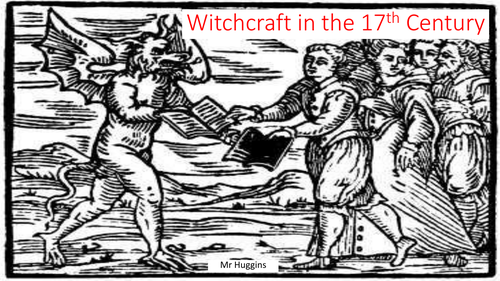


















These outstanding resources look at why people believed in witches in the seventeenth century and why there was an increase in the number of witch hunts. They are beautifully designed and differentiated for the full range of ability.
When you purchase this resource you will be able to download a four page Microsoft Word Document and an accompanying seventeen slide PowerPoint which includes information, sources, links to video clips, starters, plenaries, questions and differentiated tasks and activities. The lesson begins with a choice of starters including a snowballing activity of the key words, a buzz and go squares activity or a source analysis of witches selling their souls in return for magical powers. It then moves on to explain why people believed in witches and the social, political and economic reasons for an increase in suspicion and fear which helped to fuel an increase in witch hunting during this period. The lesson looks at how witches were identified and which groups of people were unfairly persecuted and used as a scapegoat for problems at the time.
Both resources include a range of different questions and activities which can be printed off and used with your students. The PowerPoint includes further differentiation and support material for students. These tasks and activities include source analysis questions, as well as a thinking skills review activity to extend the more able which could be used in tandem with a heads and tails activity for the less able. The lesson rounds off with an optional extended question. If you like this lesson, then you might be interested in buying the follow up lesson on ‘How Fair Were Witch Trials?’ which can be purchased separately or as a bundled resource.
The aims and objectives for this lesson are:
- Know: Why did people believe in witches in the 16th and 17th Centuries?
- Understand: Why did people hunt for witches?
- Evaluate: Why were certain people were persecuted?
- Skills: Source Analysis, Cause, Consequence & Collaboration
WILF – What Am I Looking For?
- Can You describe: Why people believed in witches in the 16th and 17th Centuries.
- Can You Explain: Why there was an increase in the number of witch hunts?
- Can You Analyse: Why were certain people were persecuted?
If you like this lesson then why not check out our TES shop, where you can find similar resources that have been bundled to provide you with further savings. You can also follow ‘The History Academy on Facebook and YouTube for the latest updates or even to get in touch and chat about how you have used this resource or to ask questions. We aim to produce resources for the price of a good cup of coffee so that you can spend more time doing the things that you want. However, we do not compromise our values and pay all our contributors the living wage for their work.
Kind Regards
Roy
Get this resource as part of a bundle and save up to 49%
A bundle is a package of resources grouped together to teach a particular topic, or a series of lessons, in one place.
Something went wrong, please try again later.
Well planned and thoroughly resourced. Thank you!
Report this resourceto let us know if it violates our terms and conditions.
Our customer service team will review your report and will be in touch.